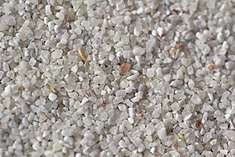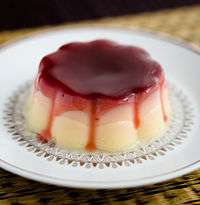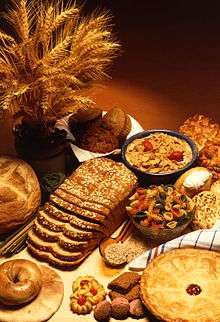Semolina
Semolina is the coarse, purified wheat middlings of durum wheat mainly used in making upma, pasta,[1] and couscous. The word semolina can also refer to sweet dessert made from semolina and milk.[1] The term semolina is also used to designate coarse middlings from other varieties of wheat, and from other grains, such as rice and maize.
 Semolina grains in close-up | |
| Nutritional value per 100 g (3.5 oz) | |
|---|---|
| Energy | 1,506 kJ (360 kcal) |
72.83 g | |
| Dietary fiber | 3.9 g |
1.05 g | |
| Saturated | 0.15 g |
| Monounsaturated | 0.124 g |
| Polyunsaturated | 0.43 g |
12.68 g | |
| Vitamins | Quantity %DV† |
| Vitamin A equiv. | 0% 0 μg |
| Thiamine (B1) | 24% 0.28 mg |
| Riboflavin (B2) | 7% 0.08 mg |
| Niacin (B3) | 22% 3.31 mg |
| Vitamin B6 | 8% 0.1 mg |
| Folate (B9) | 18% 72 μg |
| Vitamin B12 | 0% 0 μg |
| Vitamin C | 0% 0 mg |
| Minerals | Quantity %DV† |
| Calcium | 2% 17 mg |
| Iron | 9% 1.23 mg |
| Magnesium | 13% 47 mg |
| Phosphorus | 19% 136 mg |
| Potassium | 4% 186 mg |
| Sodium | 0% 1 mg |
| Zinc | 11% 1.05 mg |
| Other constituents | Quantity |
| Water | 12.67 g |
| |
| †Percentages are roughly approximated using US recommendations for adults. Source: USDA Nutrient Database | |
Etymology
Semolina is derived from the Italian word, semolino.[2] 1790–1800; alteration of Italian semolino, equivalent to semol(a) bran (≪ Latin simila flour) + -ino diminutive suffix. Semolina from the latin word simila, meaning 'flour' and the Italian word semola, means bran. It is a milled flour of durum wheat (or other hard wheat) used mainly in pasta. The words simila, semidalis, groat, and grain may all have similar proto-Indo-European origins as two Sanskrit terms for wheat, samita and godhuma, or may be loan words from the Semitic root smd – to grind into groats (cf. Arabic: سميد samīd).[3]
Production

Modern milling of wheat into flour is a process that employs grooved steel rollers. The rollers are adjusted so that the space between them is slightly narrower than the width of the wheat kernels. As the wheat is fed into the mill, the rollers flake off the bran and germ while the starch (or endosperm) is cracked into coarse pieces in the process. Through sifting, these endosperm particles, the semolina, are separated from the bran. The semolina is then ground into flour. This greatly simplifies the process of separating the endosperm from the bran and germ, as well as making it possible to separate the endosperm into different grades because the inner part of the endosperm tends to break down into smaller pieces than the outer part. Different grades of flour can thus be produced.[4]
Types
Semolina made from wheat is pale yellow in color.[5] Semolina is often used as the base for dried products such as couscous, which is made by mixing roughly 2 parts semolina with 1 part durum flour (finely ground semolina).[6]
Broadly speaking, meal produced from grains other than wheat may also be referred to as semolina, e.g. rice semolina, or corn semolina (more commonly known as grits in the U.S.).
Semolina not made from hard durum wheat (Triticum (turgidum subsp.) durum) but from the softer common wheat/ bread wheat (Triticum aestivum) in the United States is also known by the name farina. It contains more gluten, is less sandy in its texture and used more often for desserts than for salty foods.
Dishes
Savory
In Germany, Austria, Hungary, Bosnia, Bulgaria, Serbia, Slovenia, Romania and Croatia, (durum) semolina is known as (Hartweizen-)Grieß (a word related to "grits") and is mixed with egg to make Grießknödel, which can be added to soup. The particles are fairly coarse, between 0.25 and 0.75 millimeters in diameter.
In Italy, (durum) semolina is used to make a type of soup by directly boiling fine semolina in vegetable or chicken broth. Semolina can also be used for making a type of gnocchi called "Gnocchi alla Romana" , where semolina is mixed with milk, cheese and butter to form a log, then cut in discs and baked with cheese and bechamel.
.jpg)
Semolina is a common food in West Africa, especially among Nigerians. It is eaten as either lunch or dinner with stew or soup. It is prepared just like eba (cassava flour) or fufu with water and boiled for 5 to 10 minutes.
In much of North Africa, durum semolina is made into the staple couscous.
In Northern India semolina is called sooji, and in South India rava. Semolina is used to make savory South Indian foods, like rava dosa and upma. It is used to coat slices of fish before it is pan-fried in oil, to give it a crispy coating in places like Goa, India.
Sweet
In the US, semolina (specifically farina) is boiled to produce a porridge; a popular brand of this is Cream of Wheat.

In e.g. Austria, Hungary, Bosnia, Bulgaria, Slovenia, Serbia, Romania, Croatia and the Czech Republic (common wheat-) semolina (Weichweizengrieß in German) is cooked with milk and sugar. In English this kind of dessert is commonly known as semolina pudding (in German as Grießbrei).
A baked dish containing semolina called Migliaccio is present in the Neapolitan tradition in Italy; it is a mixture of ricotta, vanilla and citrus peel, similar to the filling in sfogliatelle, with added semolina flour to obtain a simple, firm cake.
In Slovakia, Sweden, Estonia, Finland, Lithuania, Latvia, Poland, Romania, Ukraine, Belarus, Israel, and Russia, it is eaten as a breakfast porridge, sometimes mixed with raisins and served with milk. In Swedish it is known as mannagrynsgröt, or boiled together with blueberries, as blåbärsgröt. In Sweden, Estonia, Finland, and Latvia, for a dessert usually eaten in summer, semolina is boiled together with juice from berries and then whipped into a light, airy consistency to create klappgröt (Swedish name), also known as vispipuuro (Finnish name) or mannavaht (Estonian name) or debessmanna (Latvian name).
In the Middle East and North Africa, harisa (also called basboosa in North African Arabic and the Alexandrian dialect of Egyptian Arabic) is made chiefly of semolina. In some cultures, it is served at funerals, during special celebrations, or as a religious offering. In North Africa, it is also used to make harcha, a kind of griddle cake often eaten for breakfast, commonly with jam or honey.[7]
On the Indian subcontinent, semolina (called suji or shuji) is used for such sweets as halwa and rava kesari. Such a preparation is also a popular dessert in Greece (halvas) and Cyprus (halvas). In Greece, the dessert galaktoboureko is made by making a custard from the semolina and then wrapping it in phyllo sheets. In Cyprus, the semolina may be mixed also with almond cordial to create a light, water-based pudding. In Turkey ("helva"), Bulgaria ("halva"), Iran ("halva"), India ("halva"), Bangladesh ("halua"), Palestine ("khalva"), and Arab countries, halawa is sometimes made with semolina scorched with sugar, butter, milk, and pine nuts. In Nepal, semolina is called suji and is used for preparing sweet dishes like haluwa (Nepali equivalent of Indian and Pakistani halwa) or puwa. In Myanmar (Burma), semolina (called shwegyi) is used in a popular dessert called sanwin makin. In Sri Lanka semolina is called "rulan" and used to make creamy porridge and a sweet confectionery called "rulan aluwa".
In baking
As an alternative to corn meal, semolina can be used to flour the baking surface to prevent sticking. In bread making, a small proportion of durum semolina added to the usual mix of flour is said to produce a tasty crust.
See also
References
- "Semolina - Definition". Merriam-Webster. Retrieved 2017-04-01.
- "Home : Oxford English Dictionary". www.oed.com. Retrieved August 25, 2019.
- Company, Houghton Mifflin Harcourt Publishing. "The American Heritage Dictionary entry: semolina". www.ahdictionary.com. Retrieved August 25, 2019.
- Wayne Gisslen (2001), Professional Baking, John Wiley & Sons
- "Semolina Flour". Spiritfoods. Archived from the original on 6 September 2012. Retrieved 21 September 2012.
- Conant, Patricia. "Grain Product Basics - Semolina and Couscous". The Epicurian Table. Retrieved 14 September 2012.
- Anthony Ham; Paula Hardy; Alison Bing; Lonely Planet Publications (2007). Morocco. Lonely Planet. p. 74. ISBN 1-74059-974-8.
External links
![]()
